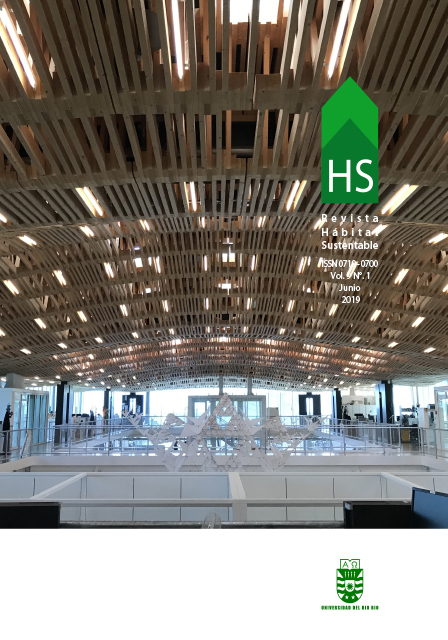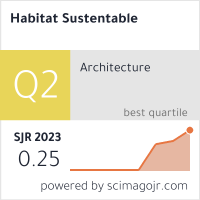Optimización de la eficiencia energética aplicando confort térmico adaptativo en un edificio de oficinas público en San Juan-Argentina
DOI:
https://doi.org/10.22320/07190700.2019.09.01.05Palabras clave:
eficiencia energética, confort térmico, edificio de oficinas, optimización de edificios, adaptación térmicaResumen
Las edificaciones son responsables del 40% de la demanda mundial de energía y de emisiones de CO2. En Argentina, los edificios representan más del 40% del consumo total anual de energía. Las estrategias de ahorro de energía pueden provocar disconformidad térmica en los habitantes de los edificios. El objetivo de este trabajo es optimizar las temperaturas de “set point” diarias basadas en los perfiles de ocupación y la evolución del clima exterior para encontrar el equilibrio entre la eficiencia energética y el confort térmico de un edificio de oficinas público en San Juan, Argentina. El modelo tiene en cuenta la capacidad de adaptación térmica de los habitantes considerando la variación de la temperatura exterior. El método propuesto combina el análisis de monitoreo in situ, que introduce datos subjetivos de ocupación, con la herramienta de simulación energética para edificios Energy Plus. Los resultados de la optimización muestran alrededor de un 26% de ahorro de energía, manteniendo condiciones aceptables de confort térmico.
Descargas
Citas
ALAMINO NARANJO, Yesica; KUCHEN, Ernesto; GIL ROSTOL, Celeste, ALONSO FRANK, Alción. Monitoreo de funcionamiento y estrategias de eficiencia energética para el edificio público de Obras Sanitarias Sociedad del Estado, San Juan, Argentina. Hábitat Sustentable, 2015, vol. 5, n° 1, pp. 14-23.
ALONSO FRANK, Alción, KUCHEN, Ernesto, ARBALLO, Bruno, ALAMINO NARANJO, Yesica. Influencia de la calidad ambiental edilicia y térmica del usuario en la eficiencia energética de edificios públicos. Caso de estudio: Edificio de Obras Sanitarias Sociedad del Estado, San juan - Argentina. Avances En Energías Renovables y Medio Ambiente, 2015.
ASHRAE 55:2004. Thermal environmental conditions for human occupancy (Supersedes ANSI/ASHRAE Standard 55:1992). ASHRAE Inc., Atlanta, USA, 2004.
BLIUC, Irina; ROTBERG, Rodica y DUMITRESCU, Laura. Assessing thermal comfort of dwellings in summer using EnergyPlus [en línea]. En: Proc. of the CLIMA 2007 World Congress Well Being Indoors, 2007. [Consultado 12 abril 2019]. Disponible en: http://www.irbnet.de/daten/iconda/CIB7648.pdf
BOESTRA, Atze. C. The adaptive thermal comfort criterion in the new EPBD IEQ Standard. BBA Indoor Environmental Consultancy, 2006.
BOERSTRA, Atze C.; VAN HOOF, Joost; VAN WEELE, A. M. A new hybrid thermal comfort guideline for the Netherlands: background and development. Architectural Science Review, 2015, vol. 58, n° 1, pp. 24-34.
CHANDEL, S. S.; SHARMA, Vandna y MARWAH, Bhanu M. Review of energy efficient features in vernacular architecture for improving indoor thermal comfort conditions. Renewable and Sustainable Energy Reviews, 2016, vol. 65, pp. 459-477.
DE DEAR, R. Thermal comfort in practice. Division of Environmental and Life Sciences, Macquarie University, Australia. Indoor Air, 2004, vol. 14, n° 7, pp. 32-39.
DERBEZ, Mickaël, BERTHINEAU, B., COCHET, V., PIGNON, C., RIBÉRON, J., WYART, G.… y KIRCHNER, S. A 3-year follow-up of indoor air quality and comfort in two energy-efficient houses. Building and Environment. 2014, vol. 82, pp. 288-299.
DOUNIS, Anastasios y CARAISCOS, Christos. Advanced control systems engineering for energy and comfort management in a building environment. A review. Renewable and Sustainable Energy Reviews, 2009, vol. 13, n° 6-7, pp. 1246-1261.
ENBOP. Energie Betriebsoptimierung [en línea]. 2008. [Consultado 12 abril 2019]. Disponible en: http://www.enob.info.
ENVIRONMENTAL PROTECTION AGENCY [en línea]. 2014. [Consultado 12 abril 2019]. Disponible en: www.epa.gov
GRIFFITHS, I. Thermal comfort studies in buildings with passive solar features, field studies. Report to the Commission of the European Community, 1990, vol. 35.
HELLWIG, Runa Tabea y BISCHOF, Wolfgang. Gültigkeit thermischer Behaglichkeitsmodelle. Bauphysik, 2006, vol. 28, n° 2, pp. 131-136.
HOLMES, Michael J. y HACKER, Jacob N. Climate change, thermal comfort and energy: Meeting the design challenges of the 21st century. Energy and Buildings, 2007, vol. 39, n° 7, pp. 802-814.
INSTITUTO ARGENTINO DE NORMALIZACIÓN Y CERTIFICACIÓN (IRAM). Acondicionamiento Térmico de Edificios.
Clasificación Bioambiental de la República Argentina. IRAM 11603:1996. Buenos Aires: Instituto Argentino de Normalización, ICS 91.120.10., CNA 5640, 1996.
ISO 7730. Moderate thermal environments – determination of the PMV and PPD indices and specifications of the conditions for thermal comfort, 1994.
ISSO 74. Thermische Behaaglijkeid. Publication 74, ISSO. Rotterdam, The Netherlands, 2004.
KUCHEN, Ernesto. Spot-Monitoring zum thermischen Komfort in Bürogebäuden. PHD Thesis. ISBN: 978-3-89959-783-7. Der Andere Verlag, S. 203. Tönning, Deutschland, 2008.
KUCHEN, Ernesto. Ventilación de espacios de trabajo en edificios de oficina y su influencia sobre la eficiencia energética. Hábitat Sustentable, 2013, vol. 3, n°2, pp. 55-65.
KUCHEN, Ernesto y FISCH, M. Norbert. Spot monitoring: thermal comfort evaluation in 25 office buildings in winter. Building and Environment, 2009, vol. 44, n° 4, pp. 839-847.
KUCHEN, Ernesto; FISCH, M. Norbert y GONZALO, Guillermo E. Modelo de Confort. Rangos de Aceptación Térmica. Avances en Energías Renovables y Medio Ambiente, 2011, vol. 14, pp. 89–96.
KUCHEN, Ernesto; PLESSER, Stefan y FISCH, M. Norbert. Eficiencia energética y confort en edificios de oficina. El caso alemán. Hábitat Sustentable, 2012, vol. 2, n°2, pp. 34-44.
MOROŞAN, Petru-Daniel; BOURDAIS, Romain; DUMUR, Didier y BUISSON, Jean. Building temperature regulation using a distributed model predictive control. Energy and Buildings, 2010, vol. 42, n° 9, pp. 1445-1452.
NETO, Alberto y FIORELLI, Flávio Augusto. Comparison between detailed model simulation and artificial neural network for forecasting building energy consumption. Energy and buildings, 2008, vol. 40, n° 12, pp. 2169-2176.
NGUYEN, Anh-Tuan; REITER, Sigrid y RIGO, Philippe. A review on simulation-based optimization methods applied to building performance analysis. Applied Energy, 2014, vol. 113, pp. 1043-1058.
NICOL, J. Fergus y HUMPHREYS, Michael A. Maximum temperatures in buildings to avoid heat discomfort. En: International Conference “Passive and Low Energy Cooling for the Built Environment”, Santorini, Greece, 2005.
PABLO-ROMERO, María del P.; POZO-BARAJAS, Rafael y YÑÍGUEZ, Rocío. Global changes in residential energy consumption. Energy Policy, 2017, vol. 101, pp. 342-352.
PÉREZ-LOMBARD, Luis; ORTIZ, José; POUT, Christine. A review on buildings energy consumption information. Energy and buildings, 2008, vol. 40, n° 3, pp. 394-398.
PROYECTO EECOM –PDTS- Res.1277/16. Eficiencia Energética y Confort en edificios públicos mediante Optimización Multiobjetivo. Director: Dr. Ernesto Kuchen. San Juan, Argentina, 2016.
SÁNCHEZ-GARCÍA, Daniel, RUBIO-BELLIDO, Carlos; MARRERO-MELÉNDEZ, Madelyn; GUEVARA-GARCÍA, Francisco y Canivell, Jacinto. El control adaptativo en instalaciones existentes y su potencial en el contexto del cambio climático. Hábitat Sustentable, 2017, vol.7, n° 2, pp. 06-17.
STAPLES. Encuesta telefónica realizada aleatoriamente a 1000 empleados de empresas PyMEs del área de Capital y Gran Buenos Aires. Argentina, 2012.
TWEED, Christopher; DIXON, Dylan; HINTON, Emma y BICKERSTAFF, Karen. Thermal comfort practices in the home and their impact on energy consumption. Architectural Engineering and Design Management, 2014, vol. 10, n° 1-2, pp. 1-24.
VAN HOOF, Joost. Forty years of Fanger’s model of thermal comfort: Comfort for all? Indoor Air, 2008, vol. 18, n° 3, pp. 182-201.
VAN HOOF, Joost; MAZEJ, Mitja y HENSEN, Jan LM. Thermal comfort: research and practice. Frontiers in Bioscience, 2010, vol. 15, n° 2, pp. 765-788.
YANG, Rui, y WANG, Lingfeng. Development of multi-agent system for building energy and comfort management based on occupant behaviors. Energy and Buildings. 2013, vol. 56, pp. 1-7.
Descargas
Publicado
Cómo citar
Número
Sección
Licencia
El contenido de los artículos que se publican en cada número de Hábitat Sustentable, es responsabilidad exclusiva de los autores y no representan necesariamente el pensamiento ni comprometen la opinión de la Universidad del Bío-Bío.
Los autores/as conservarán sus derechos de autor y garantizarán a la revista el derecho de primera publicación de su obra, el cuál estará simultáneamente sujeto a la Licencia de Reconocimiento de Creative Commons CC BY-SA que permite a otros compartir-copiar, transformar o crear nuevo material a partir de esta obra con fines no comerciales, siempre y cuando se reconozcan la autoría y la primera publicación en esta revista, y sus nuevas creaciones estén bajo una licencia con los mismos términos.











 Programa de Información Científica/Concurso Fondos de Publicación de Revistas Científicas 2018/ Proyecto Mejoramiento de Visibilidad de Revistas UBB (Código:FP180007)
Programa de Información Científica/Concurso Fondos de Publicación de Revistas Científicas 2018/ Proyecto Mejoramiento de Visibilidad de Revistas UBB (Código:FP180007) 





